Distinct roles of c-Jun N-terminal kinase isoforms in neurite initiation and elongation during axonal regeneration
- PMID: 20534829
- PMCID: PMC6632683
- DOI: 10.1523/JNEUROSCI.0372-10.2010
Distinct roles of c-Jun N-terminal kinase isoforms in neurite initiation and elongation during axonal regeneration
Abstract
c-Jun N-terminal kinases (JNKs) (comprising JNK1-3 isoforms) are members of the MAPK (mitogen-activated protein kinase) family, activated in response to various stimuli including growth factors and inflammatory cytokines. Their activation is facilitated by scaffold proteins, notably JNK-interacting protein-1 (JIP1). Originally considered to be mediators of neuronal degeneration in response to stress and injury, recent studies support a role of JNKs in early stages of neurite outgrowth, including adult axonal regeneration. However, the function of individual JNK isoforms, and their potential effector molecules, remained unknown. Here, we analyzed the role of JNK signaling during axonal regeneration from adult mouse dorsal root ganglion (DRG) neurons, combining pharmacological JNK inhibition and mice deficient for each JNK isoform and for JIP1. We demonstrate that neuritogenesis is delayed by lack of JNK2 and JNK3, but not JNK1. JNK signaling is further required for sustained neurite elongation, as pharmacological JNK inhibition resulted in massive neurite retraction. This function relies on JNK1 and JNK2. Neurite regeneration of jip1(-/-) DRG neurons is affected at both initiation and extension stages. Interestingly, activated JNKs (phospho-JNKs), as well as JIP1, are also present in the cytoplasm of sprouting or regenerating axons, suggesting a local action on cytoskeleton proteins. Indeed, we have shown that JNK1 and JNK2 regulate the phosphorylation state of microtubule-associated protein MAP1B, whose role in axonal regeneration was previously characterized. Moreover, lack of MAP1B prevents neurite retraction induced by JNK inhibition. Thus, signaling by individual JNKs is differentially implicated in the reorganization of the cytoskeleton, and neurite regeneration.
Figures

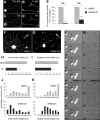
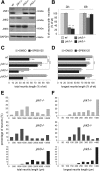
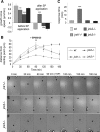
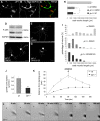

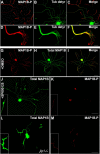
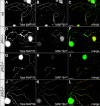
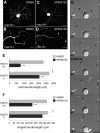

Similar articles
-
Activity of all JNK isoforms contributes to neurite growth in spiral ganglion neurons.Hear Res. 2011 Aug;278(1-2):77-85. doi: 10.1016/j.heares.2011.04.011. Epub 2011 May 1. Hear Res. 2011. PMID: 21554942 Free PMC article.
-
Arrestin-3 binds c-Jun N-terminal kinase 1 (JNK1) and JNK2 and facilitates the activation of these ubiquitous JNK isoforms in cells via scaffolding.J Biol Chem. 2013 Dec 27;288(52):37332-42. doi: 10.1074/jbc.M113.510412. Epub 2013 Nov 20. J Biol Chem. 2013. PMID: 24257757 Free PMC article.
-
JSAP1, a novel jun N-terminal protein kinase (JNK)-binding protein that functions as a Scaffold factor in the JNK signaling pathway.Mol Cell Biol. 1999 Nov;19(11):7539-48. doi: 10.1128/MCB.19.11.7539. Mol Cell Biol. 1999. PMID: 10523642 Free PMC article.
-
Brain JNK and metabolic disease.Diabetologia. 2021 Feb;64(2):265-274. doi: 10.1007/s00125-020-05327-w. Epub 2020 Nov 16. Diabetologia. 2021. PMID: 33200240 Review.
-
The Roles of c-Jun N-Terminal Kinase (JNK) in Infectious Diseases.Int J Mol Sci. 2021 Sep 6;22(17):9640. doi: 10.3390/ijms22179640. Int J Mol Sci. 2021. PMID: 34502556 Free PMC article. Review.
Cited by
-
The role of microtubule-associated protein 1B in axonal growth and neuronal migration in the central nervous system.Neural Regen Res. 2012 Apr 15;7(11):842-8. doi: 10.3969/j.issn.1673-5374.2012.11.008. Neural Regen Res. 2012. PMID: 25737712 Free PMC article. Review.
-
Stress-Activated Protein Kinases in Spinal Cord Injury: Focus on Roles of p38.Int J Mol Sci. 2018 Mar 15;19(3):867. doi: 10.3390/ijms19030867. Int J Mol Sci. 2018. PMID: 29543752 Free PMC article. Review.
-
Direct electrical stimulation impacts on neuromuscular junction morphology on both stimulated and unstimulated contralateral soleus.J Cachexia Sarcopenia Muscle. 2023 Jun;14(3):1533-1545. doi: 10.1002/jcsm.13235. Epub 2023 Apr 15. J Cachexia Sarcopenia Muscle. 2023. PMID: 37060275 Free PMC article.
-
Identification of miRNAs involved in DRG neurite outgrowth and their putative targets.FEBS Lett. 2017 Jul;591(14):2091-2105. doi: 10.1002/1873-3468.12718. Epub 2017 Jul 2. FEBS Lett. 2017. PMID: 28626869 Free PMC article.
-
Postnatal developmental dynamics of cell type specification genes in Brn3a/Pou4f1 Retinal Ganglion Cells.Neural Dev. 2018 Jun 29;13(1):15. doi: 10.1186/s13064-018-0110-0. Neural Dev. 2018. PMID: 29958540 Free PMC article.
References
-
- Ahmad FJ, Hughey J, Wittmann T, Hyman A, Greaser M, Baas PW. Motor proteins regulate force interactions between microtubules and microfilaments in the axon. Nat Cell Biol. 2000;2:276–280. - PubMed
-
- Alfei L, Soares S, Alunni A, Ravaille-Veron M, Von Boxberg Y, Nothias F. Expression of MAP1B protein and its phosphorylated form MAP1B-P in the CNS of a continuously growing fish, the rainbow trout. Brain Res. 2004;1009:54–66. - PubMed
-
- Baas PW, Ahmad FJ. Force generation by cytoskeletal motor proteins as a regulator of axonal elongation and retraction. Trends Cell Biol. 2001;11:244–249. - PubMed
Publication types
MeSH terms
Substances
Grants and funding
LinkOut - more resources
Full Text Sources
Molecular Biology Databases
Research Materials
Miscellaneous
